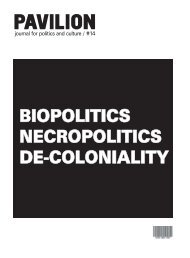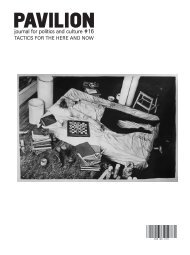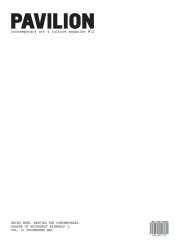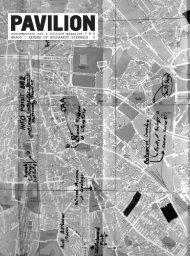PAVILION
PAVILION
PAVILION
- No tags were found...
Create successful ePaper yourself
Turn your PDF publications into a flip-book with our unique Google optimized e-Paper software.
contemporary art, as the ambiguous artpolitical<br />
mediation of the liberalism of<br />
contemporary capitalism, finds its foremost<br />
dialectical expression.<br />
3. Problematic: autonomy and dependence,<br />
individuality and collectivity<br />
I shall restrict my discussion to two main<br />
aspects of the work of art: 1) its constitution<br />
through an increasingly convoluted<br />
dialectic of autonomy and dependence,<br />
and 2) its expression of a dialectic of individuality<br />
and collectivity. The question of<br />
‘the political’ is at issue here in: 1) the<br />
political meanings of autonomy and<br />
dependence; and 2) the way in which the<br />
political contradictions of capitalist individualism<br />
are mediated and expressed<br />
by the increasing nominalism of works of<br />
art - this is the structural libertarianism of<br />
contemporary art, which underlies the<br />
radicalism of its imaginary. 16<br />
(i) The dialectic of autonomy and dependence<br />
The role of the dialectic of autonomy and<br />
dependence in the constitution of the<br />
work of art may be summarized, broadly,<br />
as follows.<br />
i) Modern art is constituted by a dialectic<br />
of autonomous and dependent elements<br />
that is expressive of what Adorno called<br />
art’s ‘double character’ as ‘autonomy and<br />
social fact’. 17<br />
ii) Autonomous art is art in which<br />
autonomous determinations ‘dominate’<br />
dependent ones; dependent art is art in<br />
which heteronomous determinations<br />
‘dominate’ autonomous ones.<br />
iii) Autonomy is an attribute of the work<br />
(albeit ‘transferred’ from the artist): the<br />
exhibition of a self-legislated ‘law of<br />
form’.<br />
iv) Self-legislated form is an illusion: the<br />
illusion of autonomous meaning-production<br />
by the work. (Works of art are thus<br />
autonomous to the extent to which they<br />
produce the illusion of their autonomy. Art<br />
is self-conscious illusion.)<br />
v) Self-legislating form positions the work<br />
in ‘resistance’ to social functionality.<br />
vi) Commodification is that form of social<br />
dependence that is, at once, the condition<br />
of, and a threat to, autonomy. (Art is<br />
a special kind of commodity, the usevalue<br />
of which resides in its uselessness<br />
or lack of social functionality.)<br />
vii) Individual works of art must actively<br />
resist heteronomous determinations of<br />
their meanings if they are to achieve<br />
autonomy.<br />
viii) The historical development of modern<br />
art is a development in the social<br />
forms and dynamics of autonomy and<br />
dependence.<br />
Politics is inscribed within the structure of<br />
this dialectic in three main ways.<br />
First, the political meaning of autonomy is<br />
freedom. The freedom of the work (its illusion<br />
of autonomy and the radicalism of its<br />
imaginary), in the present, may be<br />
viewed as a pre-figuration of a free praxis,<br />
praxis in a free society. As such, it is at<br />
the same time a criticism of the existing<br />
state of unfreedom: the work of art, any<br />
work of art, ‘criticizes society by merely<br />
existing’. 18 Here, the politics of art is a politics<br />
of form - an affirmation of freedom as<br />
self-legislating form.<br />
Second, the political meaning of heteronomy<br />
or dependence as external determination,<br />
necessity or constraint (the reality<br />
principle). Politics is one form of dependence<br />
- either within autonomous art (as a<br />
subordinate aspect) or as a type of<br />
dependent art, political art, which itself<br />
still has a (subordinate) autonomous<br />
aspect. When a political art is taken out of<br />
its practical political context, by historical<br />
change or geographical displacement,<br />
and ceases to function politically, its<br />
autonomous (formal) aspects come to<br />
the fore, and the character of the work<br />
changes. This is what happens when, for<br />
example, works of Soviet Constructivism<br />
and Productivism are displayed within<br />
Western art institutions as part of the history<br />
of the artistic avant-garde. Here, politics<br />
appears as an external condition that<br />
is nonetheless incorporated into the work<br />
as one of its conditions, but remains heteronomous<br />
- i.e. external to the self-legislation<br />
of the law of form. One may<br />
speak here of politics as ‘content’, which<br />
is not form-determining at a structural<br />
level. Rather, it depends upon the use of<br />
established forms. Hence the convergence<br />
of an artistic ‘politics of content’<br />
with academicism and historicism: the<br />
reproduction of established forms.<br />
Third, the political meaning of the dialectical<br />
unity of autonomy and dependence<br />
within the work is as a model of reconciliation.<br />
The unity of the work functions as<br />
a ‘promise of happiness’ by offering a<br />
model of reconciliation, a non-coercive<br />
identity, via the ‘belonging together’ of the<br />
one and the many.<br />
In both the first and the third cases, the<br />
political meaning inherent in art is pre-figurative,<br />
and hence ‘imaginary’. Yet it is<br />
also, thereby, in danger of being affirmative<br />
- affirmative of the society in which<br />
such pre-figuration is possible - and<br />
hence socially functional. This complicates<br />
the critical criteria for the achievement<br />
of autonomy. Subsequent to the<br />
recognition of the socially affirmative<br />
function of autonomous art 19 and the failure<br />
of both the historical avant-garde’s<br />
and institutional critique’s assault upon<br />
the institution of autonomy, there is an<br />
additional critical requirement for the<br />
achievement of autonomy. Under these<br />
conditions, critically autonomous art<br />
requires an element of anti-art - the contradictory<br />
incorporation of an un-integrated,<br />
dependent element, for which collage<br />
is the historical model - in order to mark<br />
(i.e. to render self-conscious) the illusory<br />
character of the autonomy of the artwork<br />
by re-connecting it, indexically, to the<br />
world.<br />
As a paradigm of a dependent element,<br />
politics is one paradigmatic, if paradoxical,<br />
way of rendered art critically<br />
autonomous, that is, of maintaining its<br />
autonomy in a strong, ontological<br />
sense. 20 Another paradigm is the readymade.<br />
In fact, in this critical context, the<br />
concept of the readymade expands to<br />
incorporate, in principle, all ‘readymade’<br />
elements within a work, including, standard<br />
artistic materials such as industrially<br />
manufactured paint. 21 In this respect,<br />
insofar as it reproduces an externally<br />
determined political position, the political<br />
element of an artwork may itself be conceived<br />
within the terms of the anti-art paradigm<br />
of readymade elements. However,<br />
this critical function, internal to<br />
autonomous art, only operates so long as<br />
the anti-art (dependent) element in question<br />
resists incorporation into the art institution’s<br />
conception of art. Once it is incorporated,<br />
the originally anti-art element<br />
will itself become affirmative of ‘art’ - and<br />
[124]<br />
[125]








